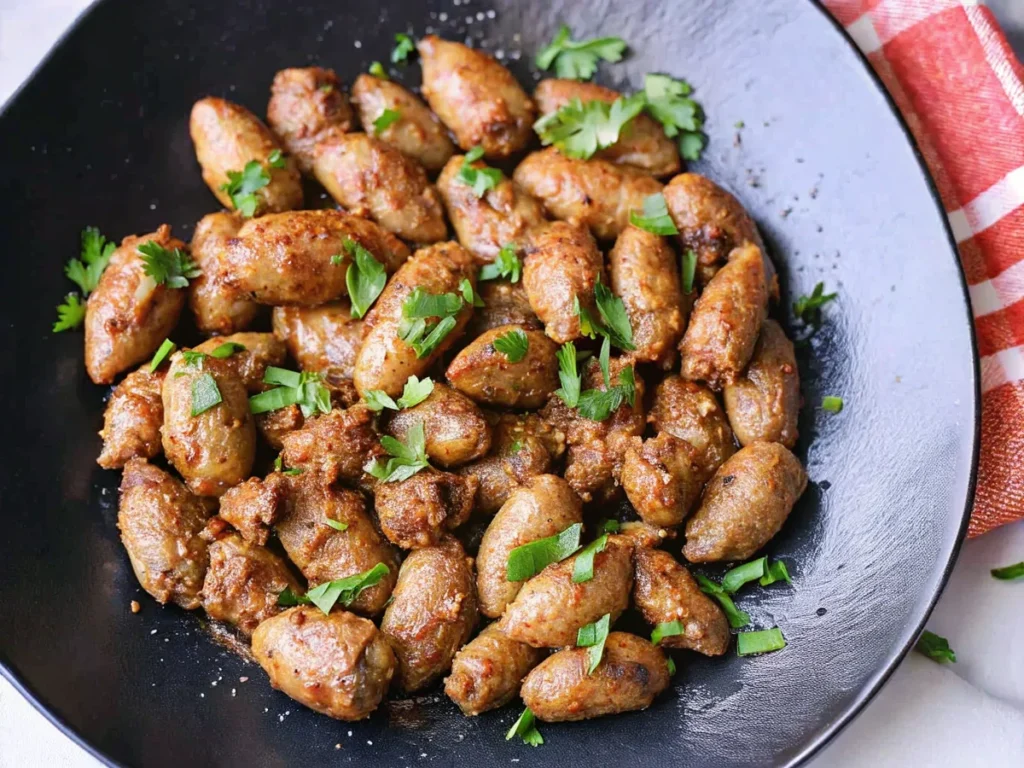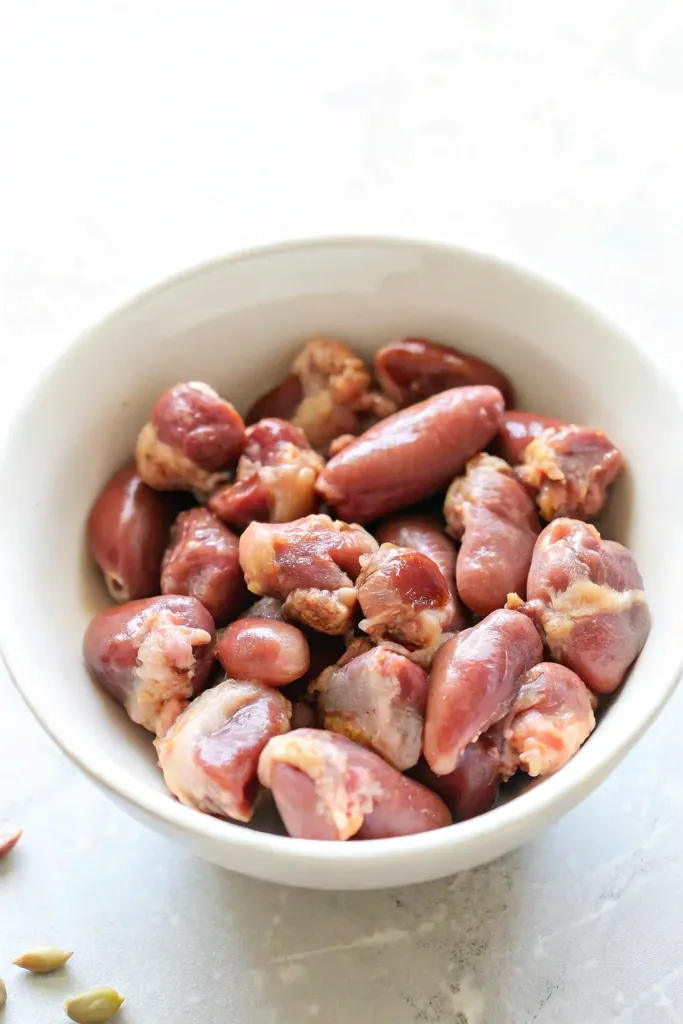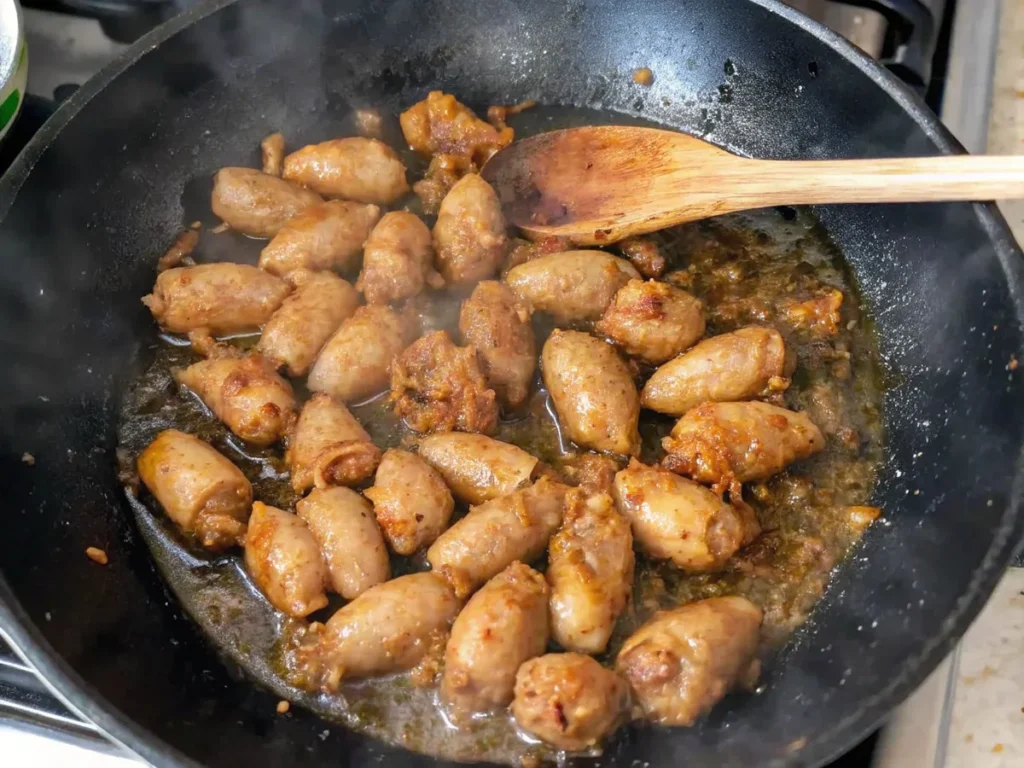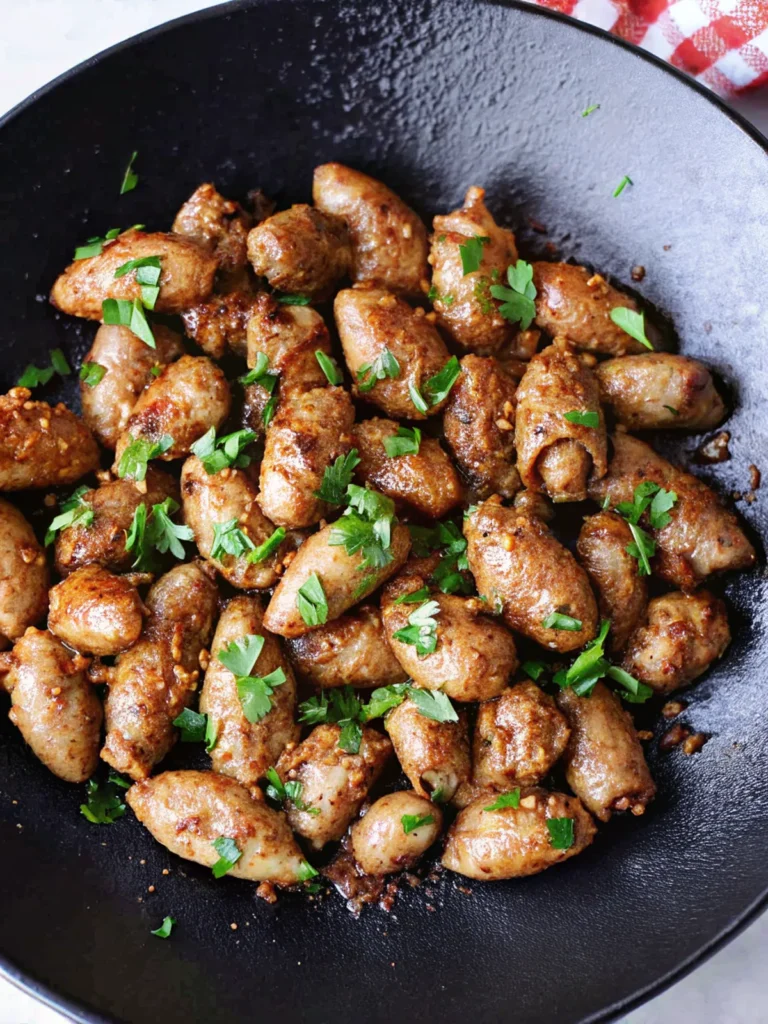Let’s talk chicken hearts. I know, I know—it might not be the first thing you think of when planning dinner. But trust me, chicken hearts are more than just edible. They’re tender, packed with flavor, and (bonus points!) super affordable. Whether you’re a foodie looking to spice things up or someone trying to stick to a budget without sacrificing taste, this recipe are about to become your new secret weapon.

Why Should You Even Bother with Chicken Hearts?
First off, they’re delicious. Seriously, don’t knock them until you’ve tried them! They’ve got this rich, almost beefy flavor—think dark meat chicken, but with a little extra oomph. And because they’re small, they cook super fast, making them a greate option for busy weeknights.
On top of that, they’re healthy. Chicken hearts are loaded with protein, iron, zinc, and an entire bunch of B nutrients. Plus, they’re low-carb and keto-friendly, in case you’re into that form of element.
And did I mention they’re lower priced? A pound of chook hearts commonly charges much less than a fancy coffee, so they’re wonderful for stretching your grocery price range.
How to Cook Chicken Hearts Like a Pro
Here’s the thing about chicken hearts: they’re crazy versatile. You can grill them, sauté them, skewer them for a backyard BBQ, or even toss them into a hearty stew. The key is to keep it simple and let their natural flavor shine.
Quick Prep Tips: Before you cook them, you’ll want to give them a quick rinse and trim off any connective tissue.
It’s not hard—just grab a sharp knife, and you’re good to go.

Ingredients
- 1 pound of chicken hearts, cleaned and trimmed
- 2 tablespoons unsalted butter
- 4 cloves garlic, minced
- 1 tablespoon olive oil
- 1 tablespoon fresh lemon juice
- 1 teaspoon salt (adjust to taste)
- ½ teaspoon black pepper
- 1 tablespoon chopped fresh parsley (optional, for garnish)
Step-by-Step Instructions
- Clean the Hearts
- Rinse them under cold water and pat them dry with a paper towel. Trim any connective tissue or excess fat with a small knife.
- Heat the Pan
- Place a large skillet over medium heat and add the olive oil. Once the oil is warm, melt 1 tablespoon of butter into the skillet.
- Sauté the Garlic
- Add the minced garlic to the skillet and cook for 30 seconds to 1 minute, stirring often. Be careful not to burn the garlic—it should just turn golden and fragrant.
- Cook the Hearts
- Toss the cleaned chicken hearts into the skillet. Spread them out into an even layer so they cook evenly. Sprinkle them with salt and black pepper.
- Stir and Brown
- Stir the chicken hearts occasionally, letting them brown on all sides. Cook for 5–7 minutes, or until the hearts are cooked through. They should feel firm but not rubbery when done.
- Add Butter and Lemon
- Add the remaining tablespoon of butter to the pan. Let it melt and coat the chicken hearts. Drizzle the lemon juice over everything for a fresh, tangy finish.
- Garnish and Serve
- Sprinkle with chopped parsley if you like a pop of color and added flavor. Serve hot over rice, mashed potatoes, or with a slice of bread to soak up the buttery sauce.

Pro Tip: For extra flavor, you can add a pinch of red chili flakes while sautéing the garlic if you like a bit of heat.
This recipe is quick, comforting, and sure to make chicken hearts a favorite in your kitchen!
Are Chicken Heart Really That Good for You?
Yup, they sure are! Here’s the rundown:
- Protein Powerhouse: A 3-ounce serving packs around 26 grams of protein.
- Iron Boost: Perfect for people who need a little help in the energy department.
- Low-Calorie Goodness: At roughly 140 calories per serving, they’re great if you’re watching your intake.

Why Americans Should Start Loving this dish
Here’s the deal: we’re kind of late to the game when it comes to offal (aka organ meats). Cultures around the world have been enjoying chicken hearts for ages—think Brazilian churrasco, Japanese yakitori, or Filipino adobo.
So, why not embrace something new? Chicken hearts are tasty, affordable, and good for you. Plus, they’re a great way to cut down on food waste and eat more sustainably.
Fun Chicken Heart Facts
- Chicken hearts are considered a delicacy in many countries, including Japan, Brazil, and the Philippines.
- They’re sometimes served at fancy restaurants as a gourmet dish. (Yes, really!)
- You can use them as pet treats—dogs love them cooked or raw!
How to Marinate Chicken Heart for Extra Flavor
Marinating chicken heart is one of the easiest ways to boost their flavor. Because they’re small and tender, they soak up marinades quickly, so you don’t need to wait hours. A simple mix of soy sauce, garlic, ginger, and a touch of honey works wonders. For a spicier kick, try blending olive oil, smoked paprika, cayenne pepper, and a splash of lime juice. Let the hearts sit in the marinade for about 30 minutes before cooking. This extra step adds a pop of flavor that makes them even more irresistible.
Chicken Heart in International Cuisine
Chicken hearts aren’t only a hidden gem in American kitchens—they’re liked international. Moreover, they maintain a special region in many culinary traditions. For example, in Brazil, they’re a should-have at churrasco, skewered and grilled till flawlessly smoky and juicy. Similarly, in Japan, fowl hearts are a standout in yakitori, lightly seasoned with salt or a sweet soy glaze earlier than being cooked over charcoal. Additionally, in the Philippines, they’re regularly braised in wealthy, savory sauces like adobo or integrated into hearty, comforting soups. In fact, these international dishes show off just how adaptable and flavorful chook hearts may be throughout one of a kind cuisines.
Are Chicken Heart Sustainable?
Yes, chicken hearts are an eco-friendly choice! By consuming organ meats like chook heart, you’re decreasing food waste and making full use of the animal. This is a win for sustainability, specially while in comparison to depending only on top cuts of meat. Plus, their low environmental footprint makes them a thoughtful preference for all people looking to devour more responsibly without sacrificing taste.
Kid-Friendly Chicken Heart Recipes
Believe it or not, this dish can be a hit with kids. The trick? Presentation. Try cutting them into bite-sized pieces and coating them in a light breadcrumb mixture before pan-frying. Serve them with a side of ketchup or BBQ sauce for dipping, and watch them disappear. Another fun idea is making mini skewers with chicken hearts and colorful veggies—it turns dinner into an interactive, playful experience.
Chicken Heart as a Budget-Friendly Protein
Let’s talk dollars and cents. With grocery prices soaring, chicken hearts are an amazing way to save money without skimping on protein. A single pound can feed a small family, especially when paired with rice, noodles, or veggies. They’re also a smart buy for meal prep—you can cook a batch and use them in salads, wraps, or stir-fries throughout the week.
Frequently Asked Questions (FAQs)
Are Chicken Hearts Good for You?
Absolutely! Chicken heart is packed with nutrients that make them a powerhouse addition to your diet. They’re rich in protein, iron, zinc, and B vitamins like B12, which are essential for energy production and healthy red blood cells. Chicken heart is also low in calories and carbs, making them a great option for people following low-carb or high-protein diets, like keto.
What Does a Chicken Heart Taste Like?
Chicken heart have a meaty, slightly gamey flavor with a tender, chewy texture. If you’re a fan of dark meat chicken, you’ll probably enjoy chicken hearts—they have that same rich taste, but with a little more intensity. When cooked properly, they’re juicy and flavorful, especially when paired with bold seasonings like garlic, soy sauce, or spices.
Do Chicken Hearts Need to Be Cleaned?
Yes, but it’s an easy process. To prepare chicken hearts, rinse them under cold water to remove any residue. Then, use a sharp knife to trim away any visible connective tissue, fat, or blood vessels. Some people also cut the hearts in half to check for any leftover blood clots, though this step isn’t strictly necessary. Proper cleaning ensures your chicken hearts are ready to cook and taste their best.
Are Chicken Hearts Healthier Than Breasts?
Chicken hearts have more iron, zinc, and B vitamins, while breasts are leaner with less fat. Both are healthy in their own way!
Final Thoughts on Chicken Hearts
I get it—organ meats may not be all of us’s first desire, especially inside the U.S. However, chicken hearts are a complete recreation-changer. In fact, they’re now not only flexible and delicious but also tremendously fun to prepare dinner with. Whether you’re whipping up a brief weeknight dinner or trying a brand new recipe, chook hearts provide infinite possibilities.
So, the following time you spot fowl hearts at the shop, don’t hesitate—grab a p.C. And give them a attempt. Who knows? They would possibly simply emerge as your new favourite aspect!
Looking for more chicken recipes? Check out Chicken Minis or try making a tasty dish with Chicken Apple Sausage.
PrintChicken Hearts: The Unsung Hero of the Protein World
Chicken hearts are a flavorful, nutrient-packed cut of meat, loved for their rich, meaty taste and tender texture. Affordable and versatile, they’re perfect for grilling, sautéing, or stewing. Packed with protein, iron, and B vitamins, chicken hearts are a healthy, delicious addition to meals and a hidden gem in the kitchen!
- Prep Time: 10 minutes
- Cook Time: 10 minutes
- Total Time: 20 minutes
- Yield: 4 servings 1x
- Category: Dinner
Ingredients
- 1 pound of chicken hearts, cleaned and trimmed
- 2 tablespoons unsalted butter
- 4 cloves garlic, minced
- 1 tablespoon olive oil
- 1 tablespoon fresh lemon juice
- 1 teaspoon salt (adjust to taste)
- ½ teaspoon black pepper
- 1 tablespoon chopped fresh parsley (optional, for garnish)
Instructions
- Clean the Hearts
- Rinse them under cold water and pat them dry with a paper towel. Trim any connective tissue or excess fat with a small knife.
- Heat the Pan
- Place a large skillet over medium heat and add the olive oil. Once the oil is warm, melt 1 tablespoon of butter into the skillet.
- Sauté the Garlic
- Add the minced garlic to the skillet and cook for 30 seconds to 1 minute, stirring often. Be careful not to burn the garlic—it should just turn golden and fragrant.
- Cook the Hearts
- Toss the cleaned chicken hearts into the skillet. Spread them out into an even layer so they cook evenly. Sprinkle them with salt and black pepper.
- Stir and Brown
- Stir the chicken hearts occasionally, letting them brown on all sides. Cook for 5–7 minutes, or until the hearts are cooked through. They should feel firm but not rubbery when done.
- Add Butter and Lemon
- Add the remaining tablespoon of butter to the pan. Let it melt and coat the chicken hearts. Drizzle the lemon juice over everything for a fresh, tangy finish.
- Garnish and Serve
- Sprinkle with chopped parsley if you like a pop of color and added flavor. Serve hot over rice, mashed potatoes, or with a slice of bread to soak up the buttery sauce.
Notes
Before you cook them, you’ll want to give them a quick rinse and trim off any connective tissue.
It’s not hard—just grab a sharp knife, and you’re good to go
Nutrition
- Calories: 190
- Fat: 10g
- Carbohydrates: 2g
- Fiber: 0g
- Protein: 23g
Keywords: Cooking Chicken Hearts, Chicken Hearts, How to Prepare Chicken Hearts

